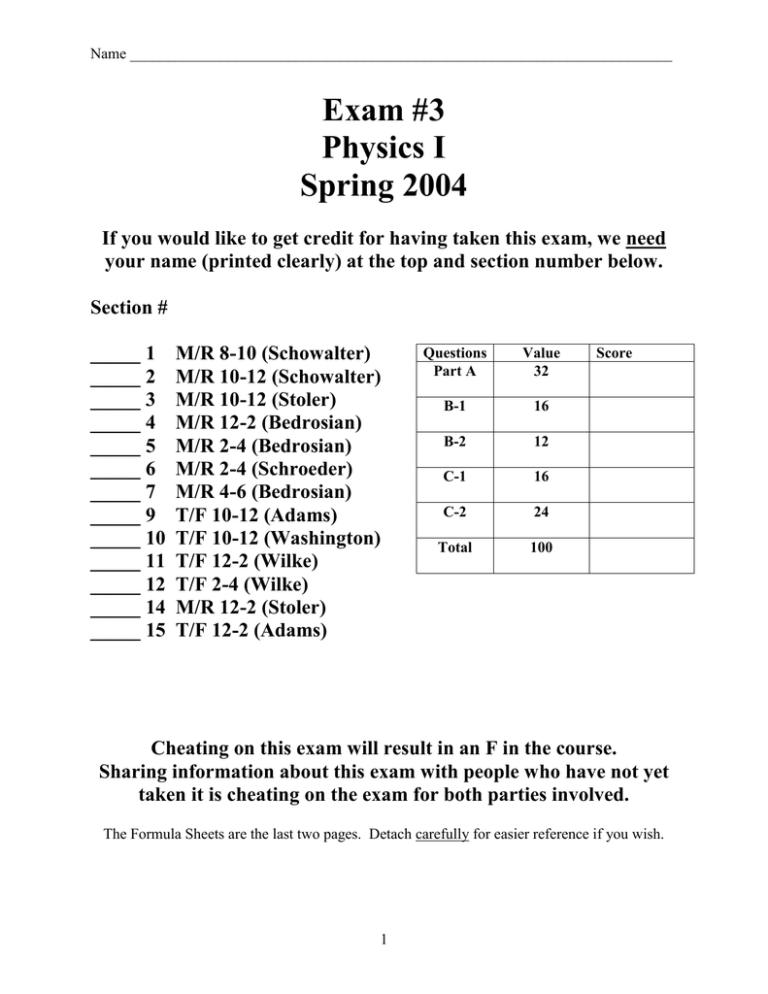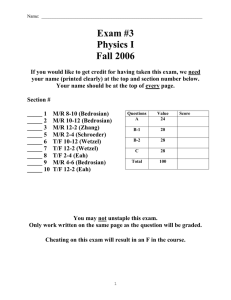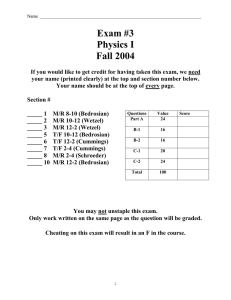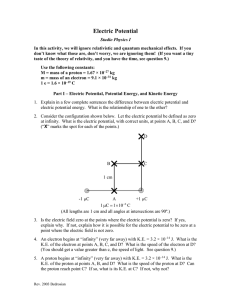Exam #3 Physics I Spring 2004
advertisement

Name ________________________________________________________________________ Exam #3 Physics I Spring 2004 If you would like to get credit for having taken this exam, we need your name (printed clearly) at the top and section number below. Section # _____ 1 _____ 2 _____ 3 _____ 4 _____ 5 _____ 6 _____ 7 _____ 9 _____ 10 _____ 11 _____ 12 _____ 14 _____ 15 M/R 8-10 (Schowalter) M/R 10-12 (Schowalter) M/R 10-12 (Stoler) M/R 12-2 (Bedrosian) M/R 2-4 (Bedrosian) M/R 2-4 (Schroeder) M/R 4-6 (Bedrosian) T/F 10-12 (Adams) T/F 10-12 (Washington) T/F 12-2 (Wilke) T/F 2-4 (Wilke) M/R 12-2 (Stoler) T/F 12-2 (Adams) Questions Part A Value 32 B-1 16 B-2 12 C-1 16 C-2 24 Total 100 Score Cheating on this exam will result in an F in the course. Sharing information about this exam with people who have not yet taken it is cheating on the exam for both parties involved. The Formula Sheets are the last two pages. Detach carefully for easier reference if you wish. 1 Name ________________________________________________________________________ On this exam, please neglect any relativistic and/or quantum mechanical effects. If you don’t know what those are, don’t worry, we are neglecting them! On all multiple-choice questions, choose the best answer in the context of what we have learned in Physics I. On numerical questions, show all work to receive credit. Part A – Warm-Ups – 32 Points Total (8 at 4 Points Each) Write your choice on the line to the left of the question number. ______ 1. A. B. C. D. ______ 2. A. B. C. D. ______ 3. A. B. C. D. ______ 4. A. B. C. D. Which statement below is a correct statement about gravity in Newton’s Theory? The force of gravity can attract or repel depending on the types of masses. The force of gravity from the earth is zero for objects in orbit around the earth. The force of gravity from the moon is zero for objects on the earth’s surface. Gravity obeys Newton’s Third Law. Which statement below is a correct statement about charges and the electric force? The magnitude of the electric force on a +1 coulomb point charge due to a second +1 coulomb point charge located 1 meter away is 1 newton. Net electric charge can be created or destroyed by nuclear reactions. The electric force depends on the charge to mass ratios of the particles involved. The electric force between any pair of charges obeys Newton’s Third Law. At a point exactly halfway between an electron and a proton, the net electric field due to the electron and proton is directed toward the electron. directed toward the proton. zero. undefined unless another charge is placed at the halfway point. An electron begins at point A with kinetic energy KA. The electric potential at point A is VA. The electron moves to point B where it has kinetic energy KB > KA. The electric potential at point B is VB. The only force on the electron is due to a static (constant in time) electric field. Which statement below must be true? VA > VB. VB > VA. VA > 0. VB > 0. 2 Name ________________________________________________________________________ Region A Region B -4e Region C +7e The next two questions refer to the figure shown above. We are interested only in points on the line shown between the two charges and its extension on either side, at a finite distance from the charges (not infinity). e = +1.6 x 10-19 C ______ 5. In which region(s) is the electric field zero at a point on the line (not infinity)? Indicate the letter(s) for all regions that apply or put zero (“0”) if you don’t think there are any points except at infinity. ______ 6. In which region(s) is the electric potential zero at a point on the line (not infinity)? Assume that the electric potential is defined to be zero at infinite distance from the charges. Indicate the letter(s) for all regions that apply or put zero (“0”) if you don’t think there are any points except at infinity. The next two questions have nothing to do with the figure above used only for questions 5 and 6. ______ 7. A. B. C. D. ______ 8. A. B. C. D. E. F. A proton begins at a point A with kinetic energy KA. The proton moves in a static (constant in time) magnetic field to a point B where it has kinetic energy KB > KA. Which statement below must be true? The magnetic field is parallel to the direction of motion at every instant. The magnetic field is perpendicular to the direction of motion at every instant. The magnetic force does positive work as follows: W = KB – KA. Another force in addition to the magnetic force acts on the proton. An electron is moving in the +Y direction in a region with a static magnetic field in the –Z direction (into the page). What is the direction of the magnetic force? +X –X +Y –Y +Z –Z Y B electron X 3 Name ________________________________________________________________________ B-1 – Graphing Potential Energy and Electric Potential – 16 Points An electron is traveling through a region of space where a static (constant in time) electric force is the only force acting on the electron: The graph of the electron’s kinetic energy (KE) is shown below as it travels from d = 0 cm to d = 100 cm. Note that the electron has the same KE at d = 0 as it does at d = 100 cm. Calculate and plot graphs of the electron’s potential energy (PE) and the electric potential as functions of position along the electron’s path. Assume both PE and electric potential start at zero at d = 0. Be sure to include: 1. Shape of the curve(s). 2. Minimum and maximum points. 3. Clearly labeled axes. Electron KE (J) 6.4 x 10-17 3.2 x 10-17 0 d (cm) 20 40 60 80 100 Electron PE (J) 0 d (cm) 20 40 60 80 100 Potential (V) 0 d (cm) 20 40 60 80 4 100 Name ________________________________________________________________________ B-2 – Electric Field and Equipotential Lines – 12 Points There are two charges +Q and –Q as shown below. Draw electric field lines and equipotential lines for the total electric field and electric potential created by these two charges. Assume the electric potential goes to zero at infinity. You will not be calculating values for the field and potential. Your objective is to show the general behavior. Include the following features: 1. The electric field lines should have arrows to indicate direction: 2. Show the equipotential line where potential is zero. Mark it “V=0” 3. Show on which sides of the zero potential line the potential is positive/negative. Clearly mark each side with “V>0” and “V<0” to show which is which. 4. Mark any point(s) where the electric field is zero. If you don’t think there are any points where the field is zero, don’t mark any points. -Q +Q (Note: The –Q charge is negative and the +Q charge is positive.) 5 Name ________________________________________________________________________ Part C – Problems – 40 Points Total C-1 Mass Spectrometer (16 points) In the mass spectrometer shown above, an ion with charge +e and mass m is accelerated from rest in an electric field from a potential of V (upper case) volts to a potential of 0 volts. The ion’s final speed is v (lower case). The ion then follows a circular arc path of radius r in a magnetic field of magnitude B. The magnetic field is at a right angle to the plane of the path. C-1-A. Find an algebraic expression for the speed v of the ion in terms of e, m, and V. v = __________________________________________________________ C-1-B. Find an algebraic expression for the speed v of the ion in terms of e, m, r, and B. v = __________________________________________________________ C-1-C. In the mass spectrometer, V = 3200 volts, r = 0.100 m, B = 1.25 T, e = 1.60 x 10-19 C. Find a numerical value for m. m = ________________________________________________ units _______ 6 Name ________________________________________________________________________ C-2 Electric Field and Potential (24 points) Calculate the electric field and electric potential at the center of the coordinate system: (0,0). Assume the electric potential is zero at infinity. There are three point charges as shown below. +1.0 x 10-9 C Y 0.3 m 0.3 m -9 –1.0 x 10 C +30° X -30° 0.3 m –1.0 x 10-9 C E field X Component: ____________________________ units ________ E field Y Component: ____________________________ units ________ Electric Potential: ____________________________ units ________ 7 Name ________________________________________________________________________ Formula Sheet for Homework and Exams – Page 1 of 2 1. v v 0 a t t 0 21. 2. x x 0 v 0 ( t t 0 ) 12 a ( t t 0 ) 2 K 12 m v 2 12 m (v x v y ) 22. 3. x x 0 12 ( v0 v)( t t 0 ) 23. K f K i Wnet U Fcons dx 4. x x 0 v( t t 0 ) 12 a ( t t 0 ) 2 24. U g m g (y y 0 ) 25. U s 12 k ( x x 0 ) 2 26. 27. 28. K U Wnoncons s r v tangential r a tangential r 2 2 6. v 2 v 02 2a x x 0 F Fnet m a 7. T 8. a centripetal 29. 30. 0 t t 0 Fcentripetal p mv dp F Fnet d t J Fnet dt p P pi dP Fext dt 31. 0 0 ( t t 0 ) 12 ( t t 0 ) 2 32. 0 12 (0 )( t t 0 ) 33. 0 ( t t 0 ) 12 ( t t 0 ) 2 M mi 38. 5. 9. 10. 11. 12. 13. 14. 15. 16. 17. 18. 19. 20. 2r v v2 2 r r v2 m m 2 r r 35. 2 02 2 0 a b a b sin( ) 36. I m i ri 34. 37. 39. 1 1 x cm m i x i y cm m i y i M M P M v cm a b a b cos() a x b x a y b y W Fd W F dx 40. 41. 42. 43. 44x. m1 v1, x ,before m 2 v 2, x ,before m1 v1, x ,after m 2 v 2, x ,after 44y. m1 v1, y ,before m 2 v 2, y ,before m1 v1, y ,after m 2 v 2, y,after m1 m 2 2 m2 v1,i v 2 ,i m1 m 2 m1 m 2 2 m1 m m1 v1,i 2 v 2 ,i m1 m 2 m1 m 2 45a. v1,f 45b. v 2,f 8 2 K rot 12 I 2 W d r F dL I d t l r p L l i L I Name ________________________________________________________________________ Formula Sheet for Homework and Exams – Page 2 of 2 m m 46a. | F | G 1 2 2 r m m 46b. F G 1 2 2 r̂ r 1 | q1 || q 2 | 47a. | F | 4 0 r2 1 q1 q 2 47b. F (r̂ ) 4 0 r 2 1 | qi | 48a. | E i | 4 0 ri 2 1 qi (r̂i ) 48b. E 4 0 ri 2 49. F q E 50. 51. 52. 1 qi 4 0 ri U qV V E dx V V x V 53y. E y y 54. F q v B mv 55. r qB 53x. E x Useful Constants (You can use the approximate values on tests.) Universal Gravitation Constant G 6.67310 11 N m 2 kg 2 6.67 10 11 Electrostatic Force Constant 1 8.987551788 10 9 N m 2 C 2 9.0 10 9 4 0 Magnetic Constant 0 4 10 7 H m 1 1.26 10 6 Speed of Light in Vacuum c 2.99792458 10 8 m s 1 3.010 8 Charge of a Proton e 1.602176462 10 19 C 1.6 10 19 Electron-Volt Conversion Constant 1eV 1.602176462 10 19 J 1.6 10 19 Mass of a Proton m p 1.6726215810 27 kg 1.67 10 27 Mass of an Electron m e 9.10938188 10 31 kg 9.110 31 9






